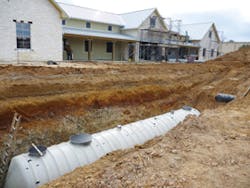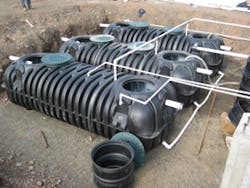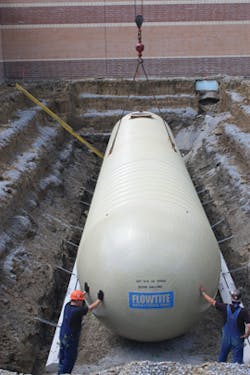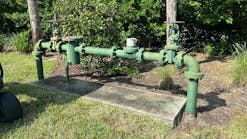St. Paul, MN, has been doing it since the early 1900s. The Primland Resort in Virginia does it. So do the US Forest Service; the city of Denver, CO; and the Lone Star Groundwater Conservation District in Texas. A Home Depot outside of Sacramento, CA, does it. Wal-Mart has been known to do it, too.
With all this activity, you might think what the industry calls “in-ground,” “buried”, or “underground” storage would be pretty much cut and dried. But buried in-vessel water storage continues to evolve, impacted by a number of factors including aesthetics and environmental concerns, weather extremes, emergency water regulations, and trends in alternative supplies.
Anyone considering storing water underground should be clear about their objectives; inform themselves on the various materials and their applications, including relative costs such as transportation and installation; and be familiar with challenges associated with topography, soil type, groundwater conditions, and such other factors as seismic stresses. No one tank type is perfect for all conditions, and managers will save themselves a lot of frustration and aggravation by consulting a professional systems designer, architect, or engineer. And it goes without saying that for installation, an experienced contractor is critical.
Why Go Underground
Common reasons for storing water underground include space constraints, viewshed protection, weather and climate considerations, security, and cost. “Demand for underground water storage has expanded exponentially,” says David Heiman at Containment Solutions, manufacturer of fiberglass tanks. “Developers don’t like aboveground tanks taking up valuable real estate. Properly installed, you can build a parking lot or a playground over a buried fiberglass or concrete tank.”
Another issue is maintenance. “Aboveground steel tanks need regular maintenance to keep them looking good, and no matter how you try to camouflage it, it’s still a big aboveground tank.”
Stephen Crawford, Engineering Manager at Crom Corporation, which manufactures large-capacity prestressed wrapped concrete tanks, says industry and private enterprise have been quick to pick up on the benefits of underground storage. Golf courses, for example, are “where land is at a premium and they’re selling luxury, and people don’t want to be distracted by an aboveground water tank.”
Wayne Lorenz, President of Wright Water Engineers, Inc., in Denver, points to weather as one reason for the predominance of underground storage in the Rocky Mountains–it beats the cost of protecting aboveground tanks from freezing temperatures.
Garth Rygh, Superintendent of Water Control at Denver Water, says underground storage has been a traditional regional choice, in part because of a topography that facilitates gravity-fed delivery systems, and in Minnesota underground storage has long been state of the art because, as Project Engineer Verne Jacobsen at TKDA in St. Paul, puts it, “People don’t want to see water towers sticking up all over the place.”
Materials
Size is a primary consideration when it comes to material. Polyethylene is generally the leader in the small-volume tank market, starting with 50-gallon rain barrels and topping out at 2–3,000 gallons. Plastic tanks are easy to handle and install, durable if the installation is done properly, and factory-manufactured, which means a quick turnaround from order to delivery. But there are drawbacks. Polyethylene tanks tend to a have a shorter life than fiberglass, their nearest competitor, and in some areas there may be concern about plastic for storing potable water and objections among environmentalists to out-of-service tanks being abandoned underground.
Polyethylene actually got off to a rough start in the liquid storage industry. Early versions were priced to compete with concrete and tended not to hold up well when subjected to excess groundwater or buried too deep. But the demand for a lightweight, easily handled alternative to concrete forced the industry to produce a better product. Polyethylene tanks are virtually maintenance-free (unless, like any other storage, your water contains silt or sediments, which must be routinely cleaned out), don’t require a liner for potable water, and can be toggled together to increase capacity.
According to Dave Kelley at Snyder Industries, which manufactures a range of plastic tanks for above- and belowground use, typical water applications include rural fire departments and state forest systems for standby fire protection and ranches in remote locations. Rainwater capture has been another application. BRAE Rainwater Technologies recently installed three 1,700-gallon Snyder polyethylene tanks at the State Botanical Garden at the University of Georgia. The idea was to conserve potable water by using the harvested rainwater off 5,000 square-feet of roof for irrigation and evaporative cooling.
“The tanks are connected in series,” says BRAE Policy Coordinator Eddie Van Giesen. “So as one fills up and drains down, they all drain down. They can also be isolated for maintenance and repair.” Van Giesen recommends that these kind of systems be inspected on a regular basis to be sure components like filters are operational. Also, when it comes to selecting an installer, he says to make sure it’s someone familiar with a systems approach in this kind of storage, so that they follow the manufacturer’s instructions “to a T”.
Underground water storage works for a variety of applications, including emergency standby and rainwater catchment.
“Groundwater can affect buried structures of any kind,” says, Bruce Stowe, Technical & Regulatory Affairs Manager at Roth-North America, another manufacturer of polyethylene tanks. “If groundwater is elevated and you pump a tank dry, you could create a buoyancy situation where the tank actually floats. The counter buoyancy measures we use to install a tank are part of the system design, and are a function of specific knowledge about the ground conditions at the intended site.”
Fiberglass
Fiberglass tanks pick up where plastic leaves off. The plastic matrix is reinforced with glass fibers to make it tougher and manufacturers point to a long, leak-free history in the petroleum industry. Fiberglass tanks range from roughly 500 gallons up to 65,000 gallons, about the size that can be transported over-the-road. Fiberglass manufactures will remind you their tanks are lightweight compared to concrete, can be trucked or air-lifted into remote sites, and take less time to install. That said, correct installation is an absolute and requires self-leveling backfill, typically one-quarter- to one-half-inch pea gravel that helps hold the tank’s structure after it’s buried. Lorenz also cautions that some types of soils, such as clay, may not be hospitable to fiberglass because of their tendency to swell.
In applications with a high water table, fiberglass tanks are typically installed using prefabricated concrete deadmen that sit on either side and provide anchors for fiberglass straps that are placed over the top of the tank’s ribs. Xerxes, a major supplier of fiberglass tanks, estimates that half its tanks are installed with anchors. Because of their structural integrity, fiberglass tanks can be loaded, and one typical space-saving and aesthetics-preserving application is to install them under parking lots. Fiberglass tanks are effectively maintenance-free, and the industry standard is a one-year warranty. To be certified for potable use, fiberglass tanks must meet National Sanitation Foundation standard 64. (See “Standards” in Additional Content.)
Like polyethylene, fiberglass tanks can also be toggled together. A Xerxes system installed in a Home Depot retail outlet in northern California provides supplemental water for fire protection with multiple 40-gallon tanks manifolded together to meet local regulations. Xerxes was also the tank of choice for the US Forest Service, which has installed 20 Xerxes fiberglass tanks for potable water storage in locations throughout the West. The fact that the tanks could be often trucked to remote sites and installed in a matter of days was an additional consideration.
Water conservation is central to the mandate of the Lone Star Groundwater Conservation District in Conroe, TX, made especially dramatic by recent droughts across the state. To help educate the public on the need for and feasibility of rainwater capture as a method of easing pressure on groundwater supplies, the district installed a demonstration rainwater harvesting system at its new office building. The system captures rainfall off the parking lot and the building’s metal roof–approximately 9,000 gallons in a 1-inch rain event–and stores the harvested water in a 15,000-gallon fiberglass tank from Containment Solutions. Water is also stored in a 10,000 gallons aboveground galvanized steel tank, which serves as an advertisement for the project.
The system includes pre-tank and post-storage filtration to preserve water quality. An automatic pump system provides pressurized rainwater for
Droughts—like the one in Texas—make water storage crucial to water resource management.
irrigation, drawing first from the15,000-gallon underground tank. When the underground tank is empty water flows into it from the aboveground tank, and when both tanks are dry, a level sensor switches the system to municipal water.
Portability and ease of installation were part of what attracted Jack Dietrich to fiberglass tanks. Dietrich is District Manager of the Crested Butte South Metropolitan Water District in Crested Butte, CO, and a principle in Water Operations, Inc., which designs and builds water storage systems. When he couldn’t get the concrete he needed for a poured-in-place reservoir for a Colorado subdivision, he specced five 30,000-gallon Darco fiberglass tanks.
“There was so much building going on around here, we couldn’t even get a quote for concrete,” he says. “I really like fiberglass for anything 150,000 gallons and under because it’s easy. You order the tank, it shows up, you plumb it, and you’re done. Once you get above 100,000 or 150,000, fiberglass is not as cost-effective, but, still, if you can’t get somebody to do concrete for you, it’s a very viable alternative.
“When you do something like this, you balance the site, the amount of water you need to store, and the materials you’ve got available. For the water district, we put in a 325,000-gallon poured-in-place rectangular concrete tank on a hillside on the inside loop of a hairpin turn. We had limited space, and we wouldn’t have been able to get the required number of fiberglass tanks in there. The rectangular shape fit right in.”
Concrete
Concrete has long been a material of choice for water storage. Precast concrete vaults are readily available for small capacity applications, and various types of prestressed poured-in-place underground tanks are in common use for large-volume municipal storage. Prestressed concrete has had internal stresses induced to balance out stresses from externally applied loads. One way of doing this is to wrap a tank in high-strength wire, and then cover it with shotcrete. Various configuration are available: 1) cast-in-place concrete with vertical prestressed reinforcement, 2) prestressed cast-in-place shotcrete with a steel diaphragm, and 3) shotcrete or precast concrete panels with a diaphragm. Whatever the configuration, concrete has its limitations, including, as Dietrich suggests, the availability of material and skilled labor, quality control, and contractor expertise–a particular challenge if a municipality is mandated to go with the lowest bidder.
A Crom Corporation wrapped cast-in-place shotcrete tank with a steel diaphragm was the design of choice for storing irrigation water at the Primland Resort in the Blue Ridge Mountains. “The crux of the design,” says Crawford, “is that the steel tank acts as a water barrier and the high-strength wire puts the tank into compression. Prestressed concrete is a very robust material, and concrete has the benefit of being inert to potable drinking water. Unless your installation is subject to saltwater infiltration, the exterior of underground concrete tanks don’t require coating.” The Primland Resort’s circular 500,000-gallon tank has an inside diameter of 75 feet, and sidewall depth of 15 feet, 8 inches. It’s buried under one of the greens it was designed to irrigate.
Buried concrete tanks can be topped with either domed roofs or, in cases where the tank is to be completely buried, flat roofs, although because it requires load-bearing columns in the interior, a flat roof can be more expensive. Aesthetics is typically the reason for a flat-roofed tank. A case in point is the replacement tank installed in a small private water district in Thousands Oaks, CA. The California Water Service Company opted to replace its aging concrete tank with a new cast-in-place, vertically prestressed tank from DYK Incorporated. For ease of installation, the new 4-million-gallon tank was built inside the walls of the original reinforced concrete tank.
“The district wanted to maximize capacity,” says DYK Regional Manager Eric Magee. “Building inside the shell of the old tank saved the cost of demolishing the original tank and shoring up the dirt at the construction site. Staying with the original site almost meant the utility could match the system hydraulics within their pressure zone. And it didn’t have to buy another piece of land and evaluate it, which would have added an additional dimension to the project.”
“The kind of strand-wrapped tank we installed doesn’t need a steel diaphragm because it’s compressed in two directions, vertically and circumferentially. The idea is to completely compress the wall for added durability. We use galvanized strands instead of wire, which is more robust, and we can put a higher force on it and go around fewer times.” Cal Water’s new 49-foot-high tank has a 122-foot inside diameter and a 46-foot water depth.
Two tennis courts and a community park top a Natgun wire-wound 1.5-million gallon underground tank that utilizes a steel diaphragm in combination with precast panels. TKDA designed the facility for the city of Stillwater, MN, to service a new upscale subdivision. The region has a long history of underground storage and a poured-in-place, spring-fed tank built in the early 1900s remains part of the Stillwater water system, providing gravity-fed water for one of the town’s two pressure zones.
The Stillwater tank was designed with an interior wall to allow for maintenance without taking the tank completely out of operation. An adjacent booster station pumps water from the aquifer into the reservoir and to a pressure set point going out.
Denver Water uses still another kind of concrete tank often referred to as post-tensioning technology, whereby concrete is poured around non-corrosive ducts in which steel tendons are positioned then subsequently tensioned. The ducts are then pumped with grout as protection against corrosion.
“The post-tensioned design is highly effective at reducing the amount of cracking,” says Rygh at Denver Water. “Any concrete shrinks over time, and when it shrinks it cracks. Our selection of the post-tensioned design is also somewhat a function of the regional expertise we have in this area, not only in engineering, but also contractors.”
Denver Water maintains over 350 million billion gallons of storage in 30 buried tanks of its own and 10 additional tanks managed by allied distributors. The tanks vary in size from half a million to 25 million gallons. Graft says that the utility’s newest tanks have exposed roofs to allow visual inspection of the roof deck. Tanks are inspected and cleaned annually.
Aside from structure, security is another factor to be considered in designing underground water storage. While underground tanks maybe one step of head because they don’t call attention to themselves, federal law now requires that water districts be responsible for security at their water installations, a consideration if underground tank installations are going to include recreational facilities. Pumps, piping, overflow, and water quality are additional factors in design and construction. “At grade, most of your piping will be directly underneath the tank,” says Crawford, “to make it easy to drain. But underground tanks, most of which are buried somewhere between three to four feet, will require additional expense, because you’re going to have to run the piping down through the tank, then come back up.”
“Overflow is one of those things that can be pushed aside, because it can be hard to address,” says Lorenz. “But you have to have somewhere for the water to go when you drain the tank, or to accommodate overflow. I advise anybody designing a storage tank to put in a mechanical overflow instead of relying on a control system indicator to tell you when a tank is full.”
Steven Sweeney of H2Options, Inc. in Denton, TX, which designed the Lone Star Groundwater District’s rainwater collection system, suggests water quality can be a particular issue for water stored in remote locations for long periods of time. “In a Forest Service application, for example, you may have that water sitting there for six months, and you want to make sure to introduce a treatment system to maintain the bacteriostatic properties of the water, as well as possibly a final polishing filter. An important consideration in this regard is to that, the treatment system is compatible with the tank material.”As anyone working in the water industry knows, various industryspecific agencies have established standards associated with water storage. NSF (formerly known as the National Sanitation Foundation) 64 is commonly cited by fiberglass tank manufacturers to verify that their tanks are suitable for potable water storage.“The most important element of the equation is the quality of the storage tank,” says David Heiman, Director of Marketing at Containment Solutions. “Tank manufacturers utilize NSF approved materials to construct a tank which meets its standards, and in the case of fi berglass tanks the material is resin. This NSF-approved resin forms the water contact surface, and when it cures with the rest of the glass-and-laminate mix, it hardens as one homogenous tank laminate.”
This being said, Tom Tietjen at Xerxes points out that its factories are NSF-inspected, and its NSF 64 certifi cation applies to the entire tank, materials, and construction, not just the interior surface.
Wrapped concert water tank manufacturers will remind you that American Waterworks Association standard D110 sets the bar for prestressed wrapped concrete tank construction (D-115 applies to the kind of post-tensioned tanks in use at Denver Water) and that they are also regulated by the American Concrete Institute. An engineer designing a concrete underground tank may tell you it meets H20 loading standards, H standing for highway and 20 meaning you could drive a 20-ton truck over the buried structure. Because compliance with all of these standards is voluntary and the organizations that draft them have no enforcement authority, how a standard actually aff ects the productivity or serviceability of a proposed installation can be diffi cult to sort out, especially because the standards eff ectively pit one kind of technology against another. An industry professional is the best source for helping mangers determine what a given standard may mean in terms of future maintenance or possible risks.









